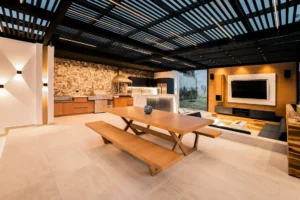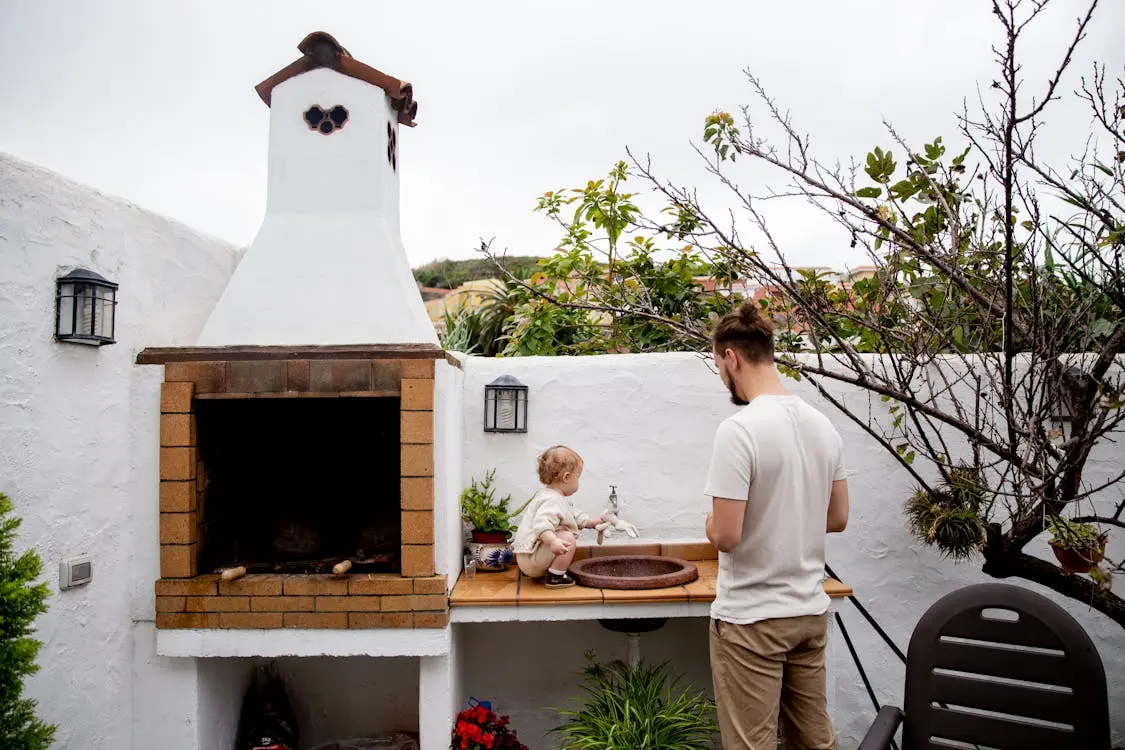DIY rustic Outdoor Kitchen Bench
For those who want to have rustic touch in your outdoor, a DIY rustic Outdoor Kitchen Bench might be required. Designed for a Diver or anyone that is interested in improving the functionality and look of your outdoor area, this guide will walk you through on how to build an outdoor kitchen bench.
Reasons to Build a Rustic Outdoor Kitchen Bench

Outdoor kitchen benches serve a few different needs. They are statement pieces that make sitting nice and cozy, but also look great on your patio or garden space. An outdoor kitchen setup benefits from a rustic style bench that:
More seating
Great for when you have guests over or if your family is a little larger.
Storage Space
You can design them with shelves or compartments to store any cooking tools, firewood and outdoor supplies With the outdoors Reclaimed wood or weathered metal tend to blend with an outdoor environment and can create a warmer, more approachable aesthetic.
Choosing Your Materials
The whole idea of rustic look is offering a natural and unpolished feel. Materials. You can choose almost anything for such an activity.
Reclaimed wood
Using reclaimed timber is one of the best ways to give that rustic look. Rustic reclaimed pallet or barn wood create a stunning worn texture for outdoor projects.
Brass details
Working in galvanized metal or iron elements adds an exposed industrial quality to your bench while still keeping true to the rustic aesthetic.
Stone or brick
You can add in stone and bricks, with some sections of the bench established from slab stones as a foundation or rock accents at the sides. This will give it a heavier and earth solid appearance.
Outdoor Varnish
Weatherproof Sealant There are a lot of types of sealing products available, so picking the right one will be important if you want this outdoor workbench to last.
Tools You’ll Need
Here are the basic tools you’ll need to build your DIY rustic Outdoor Kitchen Bench :
- Circular saw or handsaw
- Drill and screws
- Measuring tape
- Sandpaper or an electric sander
- Wood glue
- Clamps
- Paintbrush (for sealant or paint)
- Level (to ensure the bench is even)
Step-by-Step Instructions
Step 1: Measure and Plan Your Design
First, decide where you want the bench to go in your outdoor space. Measure the area and sketch a rough design for your bench. Rustic benches are typically simple, but you can add features like shelves, backs, or armrests depending on your needs.
- Pro tip: Keep the bench height around 18–20 inches and a width of about 15 inches (0.38 m) for comfortable seating.
Step 2: Cutting the Wood
now you have your info, it’s time to cut the piece of wood. Use reclaimed wood if possible to achieve a more authentic rustic look. Cut the wood for the seat, legs, and any additional features (like the back or arms of the bench).
- Pro Tip: Sand away any sharp edges, but do not go wild, you want some of those imperfections to remain as it adds the rustic character.
Step 3: Assemble the Frame
Make the frame first. Glue to glue them together with wood and then screwing is added stability. If you install a backrest, watertight storage shelves or deck plates, be sure they are all level and flush with the top surface of your hatch lid.
- Librarian Tip: Clamp wood together while glue dries so you have a strong bond.
Step 4: Screw the Seat and Legs Together
With the frame secured, you can now attach the seat of your bench. The is perched at the apex of this, which typically represents the thicker part of wood. Use screws to secure it and then screw through the frame to keep things neat by concealing your bungee. Then add the legs/supports, making sure they are evenly attached so it does not rock.
- Pro tip: A simple cross braces or under seat supports on a chair for extra stability.
- Step 5: Additional Embellishments
- To notch it up a level to look even more rustic, add some decorative details —
- And details like metal accents, such as wrought iron handles or brackets.
- Raw, unfinished rough-cut edge
- Even a few bits of peasant boards can bring veritable fervor to the bench.
You can also take a hammer and “beat” the wood lightly or use chains on it to distress it even more so making it look weathered.
Step 6: Apply Weatherproofing
The bench will be outdoors, you should apply a weatherproof sealer. To preserve the natural wood look use a clear outdoor varnish; deeper colors will require some additional color be applied in either stain or perhaps diluted paint. Be sure to cover every inch of the bench, especially at the joints so that no moisture leeches in.
Step 7: Install Your Bench
After your bench is constructed and sealed, move it to the location you selected for the outdoor kitchen or on a patio. Place the bench where it will be most useful (e.g., next to your cooking station, or as extra seating at a table). The ground underneath the Chair should be flat to avoid any wobbles.
Advantages of a Rustic Garden Bench With Kitchen

- Why would you waste your time to construct a rustic outdoor kitchen bench?
- Be-spoke: what size, shape, and features of the bench you want.
- Budget-Friendly: The cost can be cut down considerably by sourcing re-claimed or locally available products.
- Aesthetic: A bench with this character adds warmth and personality to the other side of your outdoor space.
- Saying that, you can create an outdoor furniture piece with quality materials and proper weatherproofing which will last for years.
Taking Care Of Your Outdoor Bench
This means that, like typically any outdoor furniture, your kitchen bench will need of a little maintenance. Even if you buy a brand-new iPhone, these tips will help ensure it stays that way.
Sealant re-application
- Resealing may be required once a year to every two years, depending on the amount of exposure the wood is subjected to.
- Protect it in the winter: If your winters are tough where you live, exclude or put away the bench for that period.
- Regular cleaning: Clean it often with a wet cloth to keep dirt and other residue from collecting.
Conclusion
DIY rustic outdoor kitchen bench is a fabulous freestanding piece that will enhance the overall look and feel of your backyard, lending great style ambiance to it. A new outdoor bench can perfectly accent an existing installation with the help of a few basic materials and some creativity. Since it is designed to accommodate guests forever so in evenings just at peace, your rustic benches will have all the hallmarks of superior style. Furthermore, it comes with durable build quality and can be customized to last years while requiring almost no maintenance. If you know more about us then click here.
FAQs Section
- Question 1: The most suitable wood for an outdoor kitchen bench?
A: Rustic due to its reclaimed wood, but cedar or redwood would work just fine because they are rot- and decays-resistant material like the treated pine.
- Question 2: Can I make the bench without power tools?
A: Yes, but it would take more effort. A manual hand saw and a brace with bit will work in either place, but power tools are certainly easier for these tasks than the other goodies that you can only enjoy back home.
- Q3: Can I legally give this design storage?
A: Absolutely! Seats can be made items of naughty storage via shelves or compartments under the seat.
- Q4: How long does it take to make this bench?
A: This project should take you about 5–7 hours to complete, give or take, depending on your skill level and what tools are at hand.



[…] or fail to communicate effectively. These shortcomings lead to logistical headaches, missed attractions, and an overall lacklustre experience. This duality of potential excitement and peril highlights […]